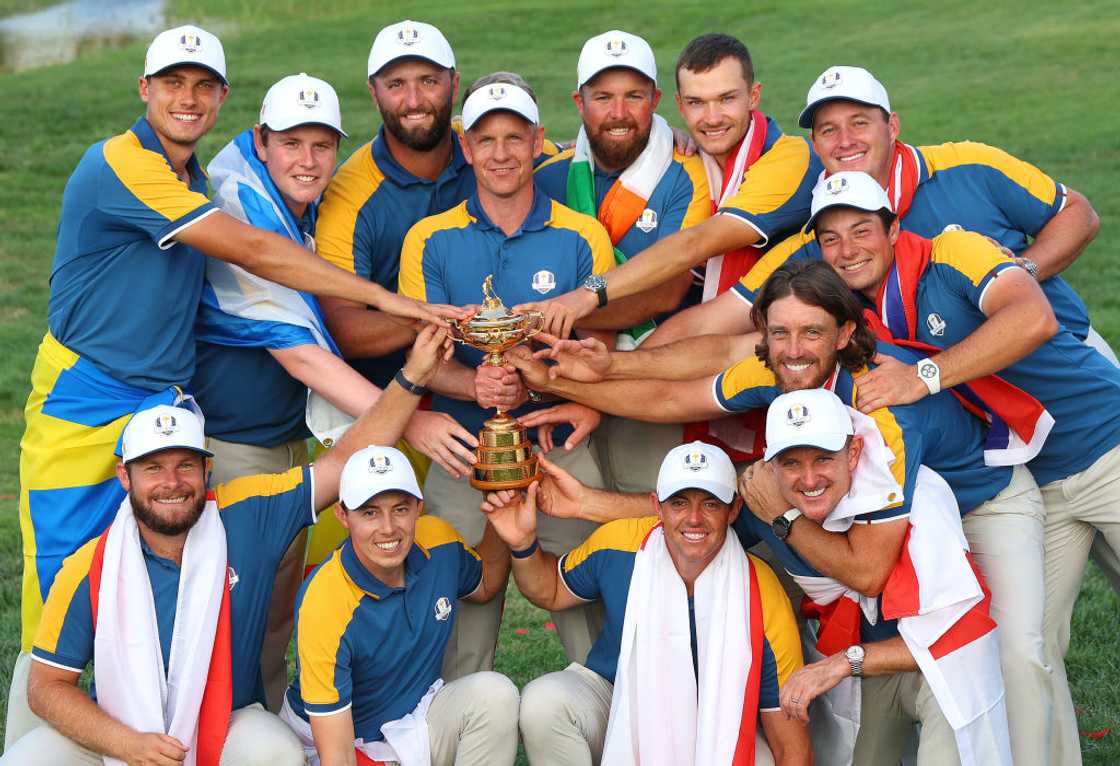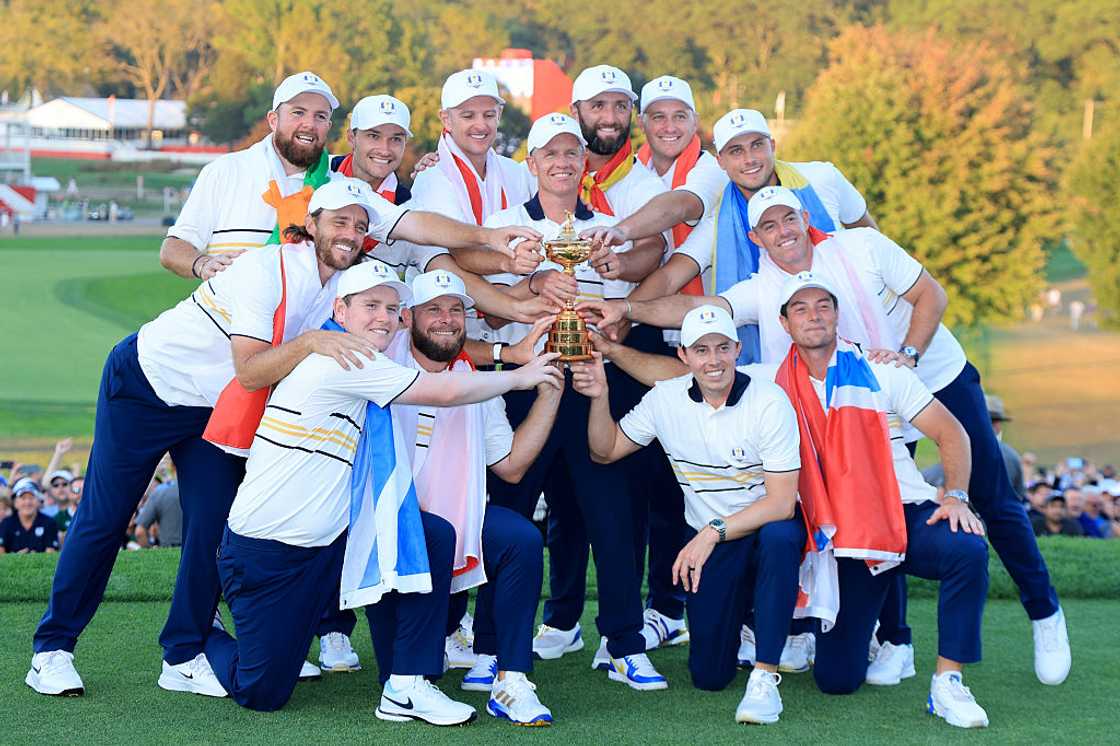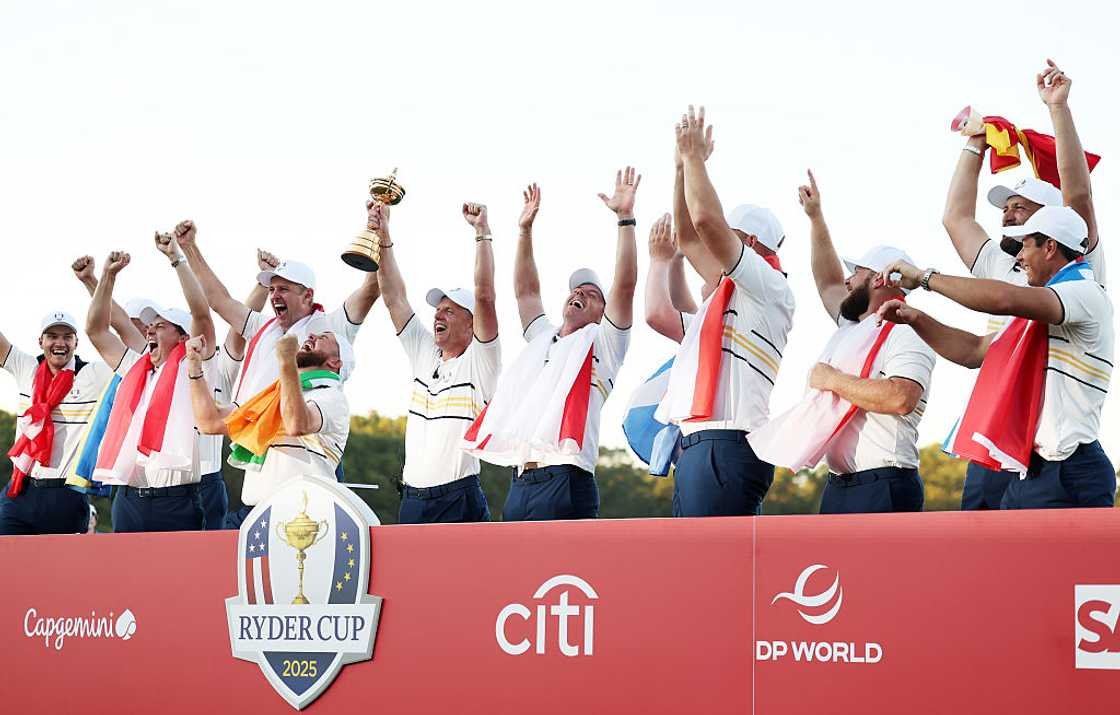Here are the details of how the Ryder Cup scoring works
Ryder Cup scoring is based on head-to-head match play that happens between the United States and Europe. The event features 28 points contested across foursomes, four-ball, and singles formats. A team must reach 14½ points to win, while the holders retain the Cup if it ends 14–14. With drama unfolding hole by hole, the scoring system turns every stroke into a story of triumph.

Source: UGC
TABLE OF CONTENTS
- Key takeaways
- What is the Ryder Cup?
- Ryder Cup scoring explained
- Types of Ryder Cup match-play formats
- What does “9 and 7” mean in the Ryder Cup?
- Why are there 28 points in the Ryder Cup?
- What is the Ryder Cup format in 2025?
- How often does the Ryder Cup take place?
- How does Four-Ball work in the Ryder Cup?
- Who leads the Ryder Cup in 2025?
- Who has won the Ryder Cup the most?
Key takeaways
- The Ryder Cup is a biennial team event between the United States and Europe.
- The competition consists of 28 matches, each worth 1 point, spread over three days.
- Four-ball, foursomes, and singles are the three formats used in Ryder Cup match play.
- A score like “9&7” means a team is 9 holes up with 7 to play, ending the match early.
What is the Ryder Cup?
The Ryder Cup is a men’s golf team competition between Europe and the United States, played every two years by 12-player teams on each side. It is a match-play event (not stroke play) named after Englishman Samuel Ryder, who donated the trophy.
Introduced in 1927, it originally pitted the U.S. against Great Britain (and later Great Britain & Ireland); since 1979, the U.S. team faces a combined Team Europe (continental Europe joined in 1979).
Over three days, the teams compete in pairs (team) matches and singles matches to earn points. The Ryder Cup alternates between venues in Europe and the U.S. at each edition.
Ryder Cup scoring explained
The Ryder Cup uses a match-play format, with 28 matches worth 28 points over three days. Each match is worth 1 point to the winner, and if the match is tied after 18 holes, both sides earn 0.5 points because no playoffs are played.
The first team to reach at least 14½ points wins the cup outright. If the score finishes 14–14, the defending champion retains the trophy. For example, as Europe won in 2023, they only needed 14 points to retain the Cup in 2025, while the U.S. team needed 14½ to win it back.

Source: Getty Images
Matches are scored hole by hole. Winning a hole by one or more strokes puts aside "1 up," while tying a hole halves it. When a side is ahead by more holes than remain, the match ends early. For instance, "3&2" means 3 up with 2 holes left, while "9&7" ends after 11 holes. The five sessions distribute the 28 points as follows:
| Day | Session | Format | Matches | Points available |
| Friday AM | Session 1 | Foursomes | 4 | 4 |
| Friday PM | Session 2 | Four-ball | 4 | 4 |
| Saturday AM | Session 3 | Foursomes | 4 | 4 |
| Saturday PM | Session 4 | Four-ball | 4 | 4 |
| Sunday | Session 5 | Singles | 12 | 12 |
| Total | _ | _ | 28 | 28 |
Types of Ryder Cup match-play formats
The Ryder Cup features three match-play formats: foursomes, four-ball, and singles. The first two days each have two team sessions (foursomes in the morning and four-ball in the afternoon), while the final day consists of 12 singles matches.
Each of the 24 players competes in one singles match on Sunday. Captains decide which players participate in each session. Here is a breakdown of the formats:
| Format | Players per side | Balls in play | Scoring method | Typical strategy |
| Four-ball (best ball) | 2 | 2 per team (4 total) | Best individual score counts each hole | Aggressive play by one partner; partner covers mistakes |
| Foursomes (alternate shot) | 2 | 1 per team (2 total) | Teams alternate shots until the hole is holed | Emphasise teamwork and complementary skills |
| Singles | 1 | 1 per player | Head-to-head match play | Pure individual match play pressure |
Four-ball (Best Ball)
In four-ball (best-ball) matches, each of the two golfers on a team plays his own ball on every hole (so four balls are in play each hole). The team’s score for the hole is the lower of the two players’ scores. For example, if Player A scores 4 and Player B scores 5 on a hole, the team’s score is 4.
The lower score of the two teams’ best-balls wins the hole. This allows top golfers to take risks, since one good score on a hole is enough to win it even if the partner does worse. If both teams’ lowest scores on a hole are the same, the hole is halved.
Winning a hole moves a side closer to winning the match, which is worth 1 point. Four-ball often encourages aggressive play: one player can go for birdies, knowing the partner’s score may still win the hole.
Foursomes (Alternate Shot)
In foursomes (alternate shot) matches, each two-person team plays one ball per hole. Team members take turns hitting the shots: one player tees off on odd-numbered holes and the other on even-numbered holes, and they alternate all subsequent strokes.

Source: Getty Images
The hole is won by the team that holes out in fewer strokes. If both teams hole out in the same number of shots, the hole is halved. This format tests teamwork and strategy, since players must adjust to each other’s play and alternate strokes.
Singles (Head-to-Head)
Singles matches are straightforward one-on-one contests. Each player plays his own ball, and the lower score on a hole wins that hole. The match continues hole by hole until one player is ahead by more holes than remain, or all 18 holes are completed.
For example, if player A leads by 3 holes with 2 holes left, the match ends 3&2. Otherwise, the final margin is expressed as “A up with B to play” or the number of holes up. Each singles win contributes 1 point to the team total, a tie 0.5, and a loss 0.
What does “9 and 7” mean in the Ryder Cup?
Match-play scoring uses shorthand notation to show margins of victory. “9 and 7” means one side was 9 holes ahead with 7 holes remaining, so the match ended after the 11th hole.
In practice, the winners had secured 9 of the first 11 holes, leaving their opponents no chance to recover. It represents the largest winning margin possible in an 18-hole match and is considered a dominant victory. For instance, Europe’s Viktor Hovland and Ludvig Åberg achieved this in the 2023 Ryder Cup, defeating the U.S. pair in a foursomes match.
Here are the most common terms and margins used.
| Notation | Meaning | When the match ends | Example |
| 1 up | Winner leads by one hole after 18 | After 18, if leader by one | Player wins by one hole |
| 3&2 | Leader 3 up with 2 to play | The match ends on the 16th hole | Leader unreachable with two holes left |
| 9&7 | Leader 9 up with 7 to play | The match ended after 11 holes | Very dominant win |
| Halved / AS (All Square) | Match tied after 18 | The match ends after 18 | Each team receives 0.5 point |
| Dormie | Leader equals holes remaining | Opponent must win all remaining holes to tie | Dormie-3 = 3 up with 3 to play |
Why are there 28 points in the Ryder Cup?
The Ryder Cup has 28 total points because there are 28 matches on the schedule. Over three days, the event includes five sessions: on each of the first two days, there are 8 team matches (4 foursomes + 4 four-ball), and on the final day, 12 singles.
This adds up to 16 team matches (Friday and Saturday) plus 12 singles on Sunday, equalling 28 matches. Each match is worth one point, so 28 points are “up for grabs”.
What is the Ryder Cup format in 2025?
The 2025 Ryder Cup took place at Bethpage Black in New York, following the traditional five-session structure: foursomes on Friday and Saturday mornings, four-balls in the afternoons, and 12 singles on Sunday. Each match lasted 18 holes, with tied matches awarding each side 0.5 points.

Source: Getty Images
The competition had 28 points in total. A team needed 14½ points to win outright. If the contest finished 14–14, the defending champion retained the Cup. Since Europe entered as the 2023 winners, they required 14 points to keep it, while the U.S. needed at least 14½ to reclaim it.
There were no playoffs or extra holes to decide the overall result. Once a team reached more than 14 points, they secured the Cup, although the remaining matches continued for record purposes.

Read also
2026 WCQ: Former Super Eagles star lambasts Nigerians celebrating South Africa's points deduction
How often does the Ryder Cup take place?
The Ryder Cup is held biennially (every two years). It alternates between courses in the United States and Europe. For example, it was played in 2023 (Rome, Italy) and will be in 2025 (New York, USA), then in 2027 in Europe, and so on.
How does Four-Ball work in the Ryder Cup?
In four-ball, each player plays their own ball for the hole. The team’s score is the lower of the two players’ scores, compared with the opponent’s best score. The side with the lower score wins the hole, while a tie means the hole is halved for 0.5 point each.
Who leads the Ryder Cup in 2025?

Source: Getty Images
Team Europe won the 2025 Ryder Cup at Bethpage Black in New York. They defeated Team USA with a final score of 15–13. The victory means Europe retained the trophy, having also won the 2023 edition. Their win at Bethpage marked another strong showing on American soil.
Who has won the Ryder Cup the most?
The United States has won 27 times. Europe, including Great Britain & Ireland, has 15 wins, with 2 contests tied. This long-standing rivalry continues to showcase golf at its highest level.
Understanding Ryder Cup scoring helps fans appreciate how every putt, every hole, and every half-point can change the outcome. With its unique blend of team spirit, strategy, and pressure, the competition delivers unforgettable moments that keep fans worldwide invested.
Legit.ng recently published an informative post about break dancing as the new Olympic sport. Break dancing, or breaking, is a street dance style that originated in New York City, United States, during the early 1970s.
Break dancing, officially known as "breaking," debuted as an Olympic sport at the 2024 Paris Games. The new sport gives dancers a global platform to compete and share their passion. Read on to discover the different types of breaking and the leading breakers in the sport.
Proofreading by Kola Muhammed, copy editor at Legit.ng.
Source: Legit.ng










